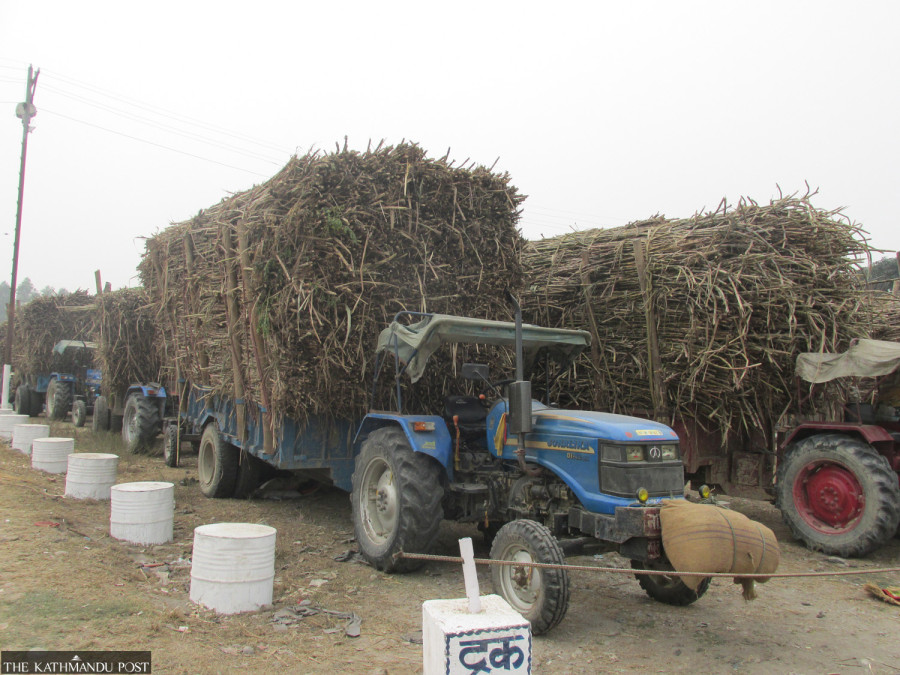Money
Sugarcane farmers begin harvest after new rate fixed
The government has increased the minimum support price of sugarcane by 8.39 percent to Rs590 per quintal. The price includes a government subsidy of Rs70 per quintal paid to sugarcane farmers.
Sunita Baral
Sugarcane farmer Ram Pratap Sah of Belgachhi-8, Gaushala is busy harvesting his cash crop.
Like Sah, many farmers in the district in the southern Tarai plain started harvesting sugarcane as soon as the government fixed the minimum support price of the crop.
But Sah is not happy with the new rates although it has been hiked by 8 percent for this harvest season.
On January 5, the government increased the minimum support price of sugarcane by 8.39 percent to Rs590 per quintal. The price includes a government subsidy of Rs70 per quintal paid to sugarcane farmers.
“That’s too little,” said Sah.“If we calculate the cost of production such as expenses of fertiliser, seed, labour, tractor, the price fixed by the government is very low.”
The floor price is the minimum price farmers get for their crops, and it is normally announced before the harvest based on recommendations from the Ministry of Agriculture and Livestock Development.
This year, it was delayed by two months.
From 2018, the government started fixing the floor price of sugarcane in a bid to end constant confrontation between sugarcane farmers and sugar producers. It had become a tradition for sugarcane growers and sugar mills to engage in a bitter dispute over the floor price during harvest time every year.
Before the government began setting the floor price, sugarcane prices in Nepal were normally based on the rates paid by Indian mills to their farmers.
Farmers have been expressing dissatisfaction over the rates for years. The low income from sugarcane has also been a discouraging factor for many farmers. Many farmers have switched to other crops.
“The price of sugarcane is not sufficient to encourage farmers. I have reduced sugarcane cultivation to 2 bighas this year, from 5 bighas. The cost of production is too high,” Sah said.
Rakesh Mishra, patron of the Sugarcane Farmers Struggle Committee, said that farmers do not get the state-subsidised fertiliser and are compelled to buy the smuggled one.
“There is no benefit from sugarcane farming. The cost of production is high but has low return,” Mishra said.
In Sarlahi, according to him, sugarcane production has declined to 300,000 tonnes from 500,000 tonnes last year mainly due to farmers not getting their payment on time and other problems like unavailability of seeds and fertiliser.
Normally, sugar mills agree to make payment within 15 days after getting sugarcane. Mills crush sugarcane within a week and sell it in the market.
“But farmers don’t get their money easily. It takes months and sometimes years to get their payment,” said Mishra.
“There is no guarantee that the farmers will get their payment within the promised date.”
There are many farmers who produce sugarcane by taking land on rent, Mishra said, adding that the liability of these farmers increases, if they don’t get payment from the mills on time.
There are many issues that have been discouraging farmers to continue sugarcane farming.
Everest Sugar Mill is reducing its crushing target every year as sugarcane cultivation is declining. The mill, which crushed 240,000 tonnes of sugarcane last year, has reduced its target to crush 220,000 tonnes this year, said Binod Kumar Yadav, chief at the Sugarcane Department of Everest Sugar and Chemical Industries.
According to the Federation of Sugarcane Producers Association, sugarcane production has plunged by around 50 percent this year with farmers facing losses and not being able to get their cost price on time. Sugarcane production has been declining continuously since 2012.
Everest Sugar Mill of Mahottari is persuading 500 to 1000 farmers daily to cut sugarcane and supply the crop to the mill.
Ram Nath Mahato, a farmer of Ishwarpur-5, Sarlahi, said he is harvesting sugarcane with the help of ten workers daily.
He sells half of the sugarcane planted on his 3 bigha every year to the Everest Sugar Mill of Mahottari and half to Indu Shankar Sugar Mill of Sarlahi.
Mahato said that he started bringing sugarcane to Mahottari after Indu Shankar asked the farmers to set fire to the sugarcane a few years ago when it had enough sugarcane.
Farmers of five districts, including Bara, Rautahat, Sarlahi, Mahottari and Dhanusha of Province-2 are supplying sugarcane to Everest Sugar Mill in Mahottari.
Everest Sugar Mill, which came into operation on December 30, has already crushed 32,803 tonnes of sugarcane by Thursday.
Yadav said that the mill has already made the payment for the sugarcane brought within January 10. The mill said farmers are being paid for their product at an interval of every five days.
Sah said that he brought sugarcane five times to the sugar mill and has already received payment.
Yadav also said that Everest Sugar Mill has decided to increase the price of an improved variety of sugarcane by Rs15 per quintal this year to encourage farmers to grow the quality crop.




 7.12°C Kathmandu
7.12°C Kathmandu















